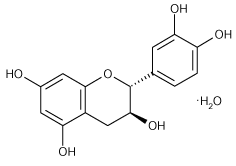Antioxidant flavonoid. Free radical scavenger. Has chemopreventive and antitumor properties.
Product Details
| Alternative Name: | (+)-3,3’,4’,5,7-Flavanpentol . H2O |
| |
| Formula: | C15H14O6 . H2O |
| |
| MW: | 290.3 (anhydrous basis) |
| |
| CAS: | 225937-10-0 |
| |
| MI: | 14: 1902 |
| |
| Purity: | ≥98% (HPLC) |
| |
| Appearance: | Off-white to yellow with a gray to tan cast. |
| |
| Solubility: | Soluble in 100% ethanol (50mg/ml). |
| |
| Shipping: | Ambient Temperature |
| |
| Long Term Storage: | +4°C |
| |
| Regulatory Status: | RUO - Research Use Only |
| |
Please mouse over
Product Literature References
Natural variation and drought-induced differences in metabolite profiles of red oak-leaf and Romaine lettuce play a role in modulating the interaction with Salmonella enterica: X. Liu, et al.; Int. J. Food Microbiol.
385, 109998 (2023),
Abstract;
Developmentally related and drought-induced shifts in the kale metabolome limited Salmonella enterica association, providing novel insights to enhance food safety: X. Liu, et al.; Food Microbiol.
108, 104113 (2022),
Abstract;
Harvest date affects aronia juice polyphenols, sugars, and antioxidant activity, but not anthocyanin stability: B. W. Bolling, et al.; Food Chem.
187, 189 (2015),
Application(s): Cell Culture,
Abstract;
Antispasmodic, bronchodilator and vasodilator activities of (+)-catechin, a naturally occurring flavonoid: M.N. Ghayur, et al.; Arch. Pharm. Res.
30, 970 (2007),
Abstract;
(+)-Catechin prevents ultraviolet B-induced human keratinocyte death via inhibition of JNK phosphorylation: W.B. Wu, et al.; Life Sci.
79, 801 (2006),
Abstract;
In vitro biological properties of flavonoid conjugates found in vivo: G. Williamson, et al.; Free Radic. Res.
39, 457 (2005), (Review),
Abstract;
Flavonoids as anticancer agents: structure-activity relationship study: M. Lopez-Lazaro; Curr. Med. Chem. Anticancer Agents
2, 691 (2002), (Review),
Abstract;
Structure-antioxidant activity relationships of flavonoids and phenolic acids: C.A. Rice-Evans, et al.; Free Radic. Biol. Med.
20, 933 (1996), (Review),
Abstract;
Adjuvant chemoprevention of experimental cancer: catechin and dietary turmeric in forestomach and oral cancer models: M.A. Azuine & S.V. Bhide; J. Ethnopharmacol.
44, 211 (1994),
Abstract;
Chemoprevention of mammary tumor virus-induced and chemical carcinogen-induced rodent mammary tumors by natural plant products: S.V. Bhide, et al.; Breast Cancer Res. Treat.
30, 233 (1994),
Abstract;












